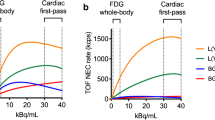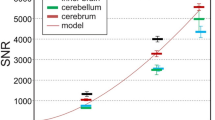Abstract
Myoblast transplantation is a promising means of restoring cardiac function in infarcted areas. For optimization of transplant protocols, tracking the location and fate of the injected cells is necessary. An attractive imaging modality for this is magnetic resonance imaging (MRI) as it is noninvasive and as iron-labeled myoblasts provide a signal attenuation in T2*-weighted protocols. The aim of this study was to develop an efficient iron-labeling protocol for myoblasts and to visualize single-labeled cells using a clinical 1.5-T scanner. Pig myoblasts were labeled with a superparamagnetic iron oxide (SPIO) agent using a liposome transfection agent. Labeling efficiency, toxicity, cell viability, and proliferative capacity were measured for 10 days. Magnetic resonance (MR) of myoblast cultures used a T2*-weighted three-dimensional protocol with a maximum in-plane resolution of 19.5 × 26.0 μm2 and 50 μm slices. Use of liposomes improved SPIO labeling efficiency. Labeling did not induce toxicity or affect cell viability or proliferation. The cell distribution as observed with light and fluorescence microscopy matched the signal voids observed in the MRI datasets. Liposomes promote fast, nontoxic and efficient SPIO labeling of myoblasts that can be tracked by MRI microscopy in clinical scanners using susceptibility-weighted protocols.
Similar content being viewed by others
References
McKay R (2000) Stem cells—hype and hope. Nature 406:361–364
Smits PC, van Geuns RJ, Poldermans D, Bountioukos M, Onderwater EE, Lee CH, Maat AP, Serruys PW (2003) Catheter-based intramyocardial injection of autologous skeletal myoblasts as a primary treatment of ischemic heart failure: Clinical experience with six-month follow-up. J Am Coll Cardiol 42:2063–2069
Hassink RJ, Brutel de la Riviere A, Mummery CL, Doevendans PA (2003) Transplantation of cells for cardiac repair. J Am Coll Cardiol 41:711–717
van den Bos EJ, Thompson RB, Wagner A, Mahrholdt H, Morimoto Y, Thomson LEJ, Wang LH, Duncker DJ, Judd RM, Taylor DA (2004) Functional assessment of myoblast transplantation for cardiac repair with magnetic resonance imaging. Eur J Heart Fail (in press)
Frank JA, Zywicke H, Jordan EK, Mitchell J, Lewis BK, Miller B, Bryant LH Jr, Bulte JW (2002) Magnetic intracellular labeling of mammalian cells by combining (FDA-approved) superparamagnetic iron oxide MR contrast agents and commonly used transfection agents. Acad Radiol 9:S484–S487
van den Bos EJ, Wagner A, Mahrholdt H, Thompson RB, Morimoto Y, Sutton BS, Judd RM, Taylor DA (2003) Improved efficacy of stem cell labeling for magnetic resonance imaging studies by the use of cationic liposomes. Cell Transplant 12:743–756
Lameris TW, de Zeeuw S, Duncker DJ, Tietge W, Alberts G, Boomsma F, Verdouw PD, van den Meiracker AH (2002) Epinephrine in the heart: uptake and release, but no facilitation of norepinephrine release. Circulation 106:860–865
Wang YX, Hussain SM, Krestin GP (2001) Superparamagnetic iron oxide contrast agents: Physicochemical characteristics and applications in MR imaging. Eur Radiol 11:2319–2331
Dodd SJ, Williams M, Suhan JP, Williams DS, Koretsky AP, Ho C (1999) Detection of single mammalian cells by high-resolution magnetic resonance imaging. Biophys J 76:103–109
Foster-Gareau P, Heyn C, Alejski A, Rutt BK (2003) Imaging single mammalian cells with a 1.5 T clinical MRI scanner. Magn Reson Med 49:968–971
Crich SG, Biancone L, Cantaluppi V, Duo D, Esposito G, Russo S, Camussi G, Aime S (2004) Improved route for the visualization of stem cells labeled with a Gd-/Eu-chelate as dual (MRI and fluorescence) agent. Magn Reson Med 51:938–944
Fleige G, Seeberger F, Laux D, Kresse M, Taupitz M (2002) In vitro characterization of two diferent ultrasmall iron oxide particles for magnetic resonance cell tracking. Invest Radiol 37:482–488
Bulte JW, Zhang S, van Gelderen P, Herynek V, Jordan EK, Duncan ID, Frank JA (1999) Neurotransplantation of magnetically labeled oligodendrocyte progenitors: Magnetic resonance tracking of cell migration and myelination. Proc Natl Acad Sci USA 96:15256–15261
Yeh T, Zhang W, Ilstad S, Ho C (1993) Intracellular labeling of T-cells with Superparamagnetic contrast agents. Magn Reson Med 30:617–625
Moore A, Grimm J, Han B, Santamaria P (2004) Tracking the recruitment of diabetogenic CD8+ T-cells to the pancreas in real time. Diabetes 53:1459–1466
Acknowledgments.
The authors wish to thank Dr. Linda Everse, Ph.D. for helping to revise the manuscript and helpful advice regarding experimental methodology, and Herman Flick (Flick Engineering B.V., The Netherlands) for providing the dedicated receiver coil used for the MRI experiments.
Author information
Authors and Affiliations
Corresponding author
Rights and permissions
About this article
Cite this article
Zhang, Z., van den Bos, E., Wielopolski, P. et al. High-resolution magnetic resonance imaging of iron-labeled myoblasts using a standard 1.5-T clinical scanner. MAGMA 17, 201–209 (2004). https://doi.org/10.1007/s10334-004-0054-8
Received:
Revised:
Accepted:
Published:
Issue Date:
DOI: https://doi.org/10.1007/s10334-004-0054-8




